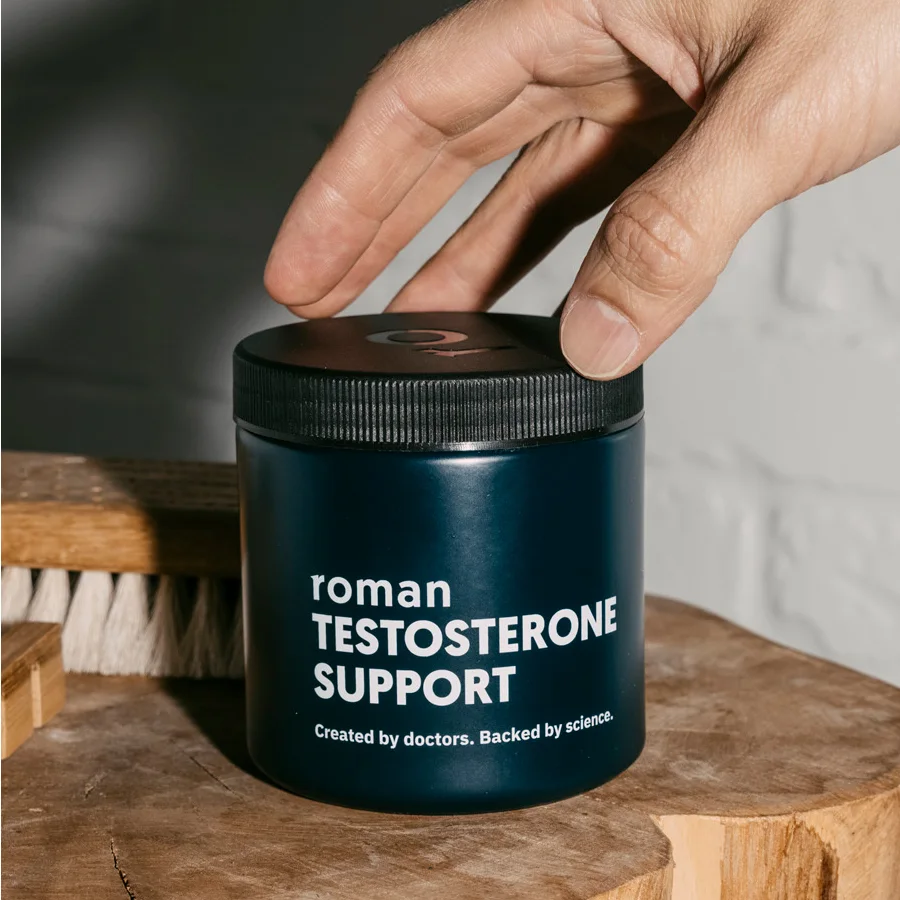Here's what we'll cover
Here's what we'll cover
Here's what we'll cover
If you’re on the hunt for a testosterone cream, you’ll be searching for a while because there are no mass-manufactured testosterone creams available in the United States—only gels. To get topical testosterone in a cream form, you need to place a custom order through a compounding pharmacy. While several over-the-counter products are marketed as “testosterone creams,” they don’t contain any testosterone.
Read on to learn more about the importance of testosterone and what to consider when thinking about using testosterone cream.
Why is testosterone cream prescribed?
To understand why your healthcare provider may prescribe a topical testosterone product, let’s first talk about what testosterone is and what it does for the body.
Testosterone (often just called “T”) is the primary male sex hormone (androgen), and estrogen is its female counterpart. But we all, male or female, need both hormones. Men manufacture most of their testosterone in the testicles, while women produce a smaller amount in the ovaries.
And it helps regulate many functions. A healthy baseline serum testosterone level is necessary for well-being in both sexes. In addition to sex drive and sexual function, testosterone helps build and maintain muscle mass and bone strength (Tyagi, 2017).But, over time, T levels often dip—especially after a certain age. Researchers estimate that around 40% of men over 45 have clinically low testosterone levels, also called hypogonadism (Sizar, 2021).
Your testosterone levels may also decrease due to medical conditions or as a side effect of some medical treatments. Low T can cause several unpleasant symptoms, but luckily, it’s treatable with testosterone replacement therapy (TRT). TRT comes in many forms, including gels, patches, injections, and, sometimes, creams.
Testosterone cream vs. testosterone gel
One of the most common TRT formulations is testosterone gel, which is applied to and absorbed through the skin. Common brands include Androgel, Testim, and Fortesta. Gels are clear and water-based and typically contain a high percentage of alcohol.
By contrast, creams are an emulsion of oil and water. Studies have shown medication in gels absorbs faster and more efficiently than those in the form of creams (Seth, 1993). And creams must contain a higher quantity of their active agent to achieve the same effect. In one of the few testosterone-specific studies of creams vs. gels, researchers found a 5% testosterone cream was biologically equivalent to a 1% testosterone gel (Wittert, 2016).
Both creams and gels leave residual testosterone on the skin’s surface. This residue can transfer to other people and cause undesirable effects. Because gels absorb faster and more thoroughly than creams, the risk of transferring residual testosterone to someone else is theoretically lower with a gel than a cream (Petering, 2017).
When to choose testosterone creams over gels
Given the advantages of gels, you may wonder, why use creams at all?
Gels can be drying and irritating for some people whose skin is dry in the area where the gel is applied. And because of the high alcohol content, gels can be painful to apply to sensitive areas, such as the vagina or scrotum. Most topical T gels are usually applied to the upper arms. However, researchers found intravaginal testosterone cream highly effective at relieving vulvovaginal atrophy and other sexual side effects of breast cancer medication (Davis, 2018).
So, if you have a reaction to a testosterone gel or if your healthcare provider thinks a cream is more suitable to your needs, they may recommend cream-based topical testosterone over gel-based.
Currently, all commercially produced topical testosterone in the United States is gel-based. If your healthcare provider prescribes testosterone cream, you can’t pick it up at a regular local pharmacy. Because there are no FDA-approved commercial testosterone creams, they must be custom-made. You’ll need to go to a compounding pharmacy for this prescription.
Compounding pharmacies are pharmacies licensed to make custom formulations. For example, they can mix a new pill for a patient with an allergy to a dye used in its commercial form. They can also convert tablets into liquids for people with trouble swallowing. A compounding pharmacy will essentially create the testosterone cream for you.
Uses for testosterone replacement therapy
Testosterone levels play a life-long role in your health. Currently, testosterone therapy is only FDA-approved to treat hypogonadism in men. Low testosterone levels can lead to various symptoms.
Healthcare providers may also prescribe testosterone off-label to treat other conditions. Some providers use it for postmenopausal women with hypoactive sexual desire disorder (Parish, 2021). It may also help trans men go through gender affirmation (Costa, 2018).
Symptoms of low testosterone
Testosterone affects many different bodily functions. That’s why people with low testosterone levels may experience a wide range of seemingly unrelated signs and symptoms, such as (Sizar, 2021):
Decreased libido
Erectile dysfunction (with loss of morning erections)
Fatigue
Loss of muscle mass
Increased body fat
Anemia
Loss of bone mass (osteoporosis)
Depressed mood
Fertility issues (e.g., low sperm count)
Risks of topical testosterone
Topical testosterone leaves a residue on the skin, which can transfer to other people. Take care to cover the application site with clothing after drying. After application, you should wash your hands thoroughly with soap and water (DailyMed, 2021).
Avoid skin-to-skin contact with the application site. If exposed to topical testosterone, women may experience abnormal body hair growth, irregular periods, voice deepening, and male pattern baldness (de Ronde, 2009). If you are pregnant or could become pregnant, you should not use testosterone and avoid coming into contact with it. Children exposed to transdermal testosterone may develop pubic hair, enlarged genitalia, bone issues, and aggressive behavior (DailyMed, 2021)
Men with breast cancer and those who have or might have prostate cancer should not use topical testosterone (DailyMed, 2021).
And before using topical testosterone, make sure to tell your healthcare provider about all other medications, both prescription and over-the-counter, that you are taking. Let them know about any supplements, including herbal supplements, that you are taking as well. Drug interactions may occur with the following medications and include (DailyMed, n.d.):
Anticoagulants (blood thinners) including warfarin (brand name Coumadin)
Insulin
Corticosteroids, including dexamethasone, methylprednisolone (brand name Medrol), and prednisone
It’s also important to tell your healthcare professional if you have or have had any of the following conditions (DailyMed, n.d.):
Sleep apnea
Benign prostate hyperplasia (BPH), also known as enlarged prostate
Heart, kidney, liver, or lung disease.
Hypercalcemia (high blood calcium)
Side effects of topical testosterone
Do not use more than the prescribed amount of topical testosterone. Abuse may cause heart failure, stroke, blood clots, seizures, mania, hallucinations, and delusions, among other adverse effects (DailyMed, 2021).
Even regular testosterone use may cause side effects in some people, including (DailyMed, 2021):
Loss of sexual desire
Mood changes
Headache
Skin irritation, itching, or redness
Frequent urination
Hyperlipidemia (high cholesterol)
Testosterone replacement therapy may affect your sperm count. It may also increase the risk of prostate cancer.
Over-the-counter “testosterone” creams
You may have seen several products in stores called “testosterone creams” available without a prescription. These alleged testosterone products don’t contain a single testosterone molecule.
Testosterone is only available with a prescription, so nothing sold over-the-counter in the United States contains it. And while vague claims of male enhancement and curing sexual dysfunction adorn the labels, these products are not subjected to clinical trials and have no approval by the FDA.
These products can’t be banned outright, but the FDA can stop them from misleading you with marketing. Many have changed their names to things that sound like but-aren’t-quite testosterone, like TestroMax and Test-Boost (though the latter sounds more appropriate for increasing your SAT scores). Some claim to have “homeopathic testosterone,” which is another way of saying “no testosterone.”
Do some of the ingredients work, though? Are they just fancy-sounding placebos? They all have different formulas, and we won’t review them all. But ingredients that keep popping up in these creams are DHEA, saw palmetto, and Tribulus terrestris.
DHEA
DHEA, also known as dehydroepiandrosterone, is a hormone precursor. It’s part of the production team that makes testosterone and the related dihydrotestosterone (DHT).Our bodies produce DHEA naturally and use it to synthesize androgen and estrogen sex hormones. The FDA has approved DHEA as an androgen therapy for postmenopausal women as studies show that it may relieve many genitourinary symptoms associated with menopause (Vegunta, 2020).
Would a boost in DHEA, in turn, boost testosterone concentrations? Research hasn’t shown that. A meta-analysis of multiple studies found that while DHEA might have some positive effects, it did not appear to raise testosterone levels significantly, if at all (Kovac, 2015).
Saw palmetto
Saw palmetto is a palm tree that grows in the Southeastern United States. Some believe the extract from its fruit can treat lower urinary tract symptoms related to an enlarged prostate. There may be some mild benefits, but the science is somewhat mixed (Grant, 2012).
First, no study has suggested that testosterone levels increase when taking it. Second, there has been no research into its effectiveness with a topical delivery system like a cream. It may not do anything at all if applied to the skin.
Tribulus terrestris
Tribulus terrestris is an herb in the caltrop family, long purported to elevate T levels. It’s a popular addition to herbal workout supplements. However, there is limited scientific evidence that this herb boosts testosterone (Pokrywka, 2014).
Beyond that, as with saw palmetto, there’s nothing to confirm it can even be absorbed through the skin. Whatever potential benefits it might have might not even matter in a cream.
Exercise caution
Since creams take longer to dry than gels, you have to be a bit more careful about transferring the testosterone to others. If you’re receiving testosterone replacement therapy and find gels dry your skin or have other irritating effects, a cream might be the easiest solution—just exercise caution.
DISCLAIMER
If you have any medical questions or concerns, please talk to your healthcare provider. The articles on Health Guide are underpinned by peer-reviewed research and information drawn from medical societies and governmental agencies. However, they are not a substitute for professional medical advice, diagnosis, or treatment.
References
Costa, L. B. F., de Sá Rosa-E-Silva, A. C. J., de Medeiros, S. F., Nacul, A. P., de Carvalho, B. R., Benetti-Pinto, C. L., et al. (2018). Recommendations for the use of testosterone in male transgender. Revista Brasileira De Ginecologia E Obstetricia: Revista Da Federacao Brasileira Das Sociedades De Ginecologia E Obstetrici a, 40 (5), 275–280. doi: 10.1055/s-0038-1657788. Retrieved from https://pubmed.ncbi.nlm.nih.gov/29913543/
DailyMed. (2021) Testosterone gel . Retrieved Feb. 2, 2022 from https://dailymed.nlm.nih.gov/dailymed/drugInfo.cfm?setid=2d55b825-8eab-4091-bdf2-9c52d111b8eb
Davis, S. R., Robinson, P. J., Jane, F., White, S., White, M., & Bell, R. J. (2018). Intravaginal testosterone improves sexual satisfaction and vaginal symptoms associated with aromatase inhibitors. The Journal of Clinical Endocrinology and Metabolism , 103 (11), 4146–4154. doi: 10.1210/jc.2018-01345. Retrieved from https://pubmed.ncbi.nlm.nih.gov/30239842/
de Ronde, W. (2009). Hyperandrogenism after transfer of topical testosterone gel: Case report and review of published and unpublished studies. Human Reproduction (Oxford, England), 24 (2), 425–428. doi: 10.1093/humrep/den372. Retrieved from https://pubmed.ncbi.nlm.nih.gov/18948313/
Grant, P. & Ramasamy, S. (2012). An update on plant derived anti-androgens. International Journal of Endocrinology and Metabolism , 10 (2), 497–502. doi: 10.5812/ijem.3644. Retrieved from https://pubmed.ncbi.nlm.nih.gov/23843810/
Khodamoradi, K., Khosravizadeh, Z., Parmar, M., Kuchakulla, M., Ramasamy, R., & Arora, H. (2021). Exogenous testosterone replacement therapy versus raising endogenous testosterone levels: Current and Future Prospects. F&S Reviews , 2 (1), 32–42. doi: 10.1016/j.xfnr.2020.11.001. Retrieved from https://pubmed.ncbi.nlm.nih.gov/33615283/
Kovac, J. R., Pan, M., Arent, S., & Lipshultz, L. I. (2016). Dietary adjuncts for improving testosterone levels in hypogonadal males. American Journal of Men’s Health , 10 (6), NP109–NP117. doi: 10.1177/1557988315598554. Retrieved from https://pubmed.ncbi.nlm.nih.gov/26272885/
Parish, S. J., Simon, J. A., Davis, S. R., Giraldi, A., Goldstein, I., Goldstein, S. W., et al. (2021). International Society for the Study of Women's Sexual Health clinical practice guideline for the use of systemic testosterone for hypoactive sexual desire disorder in women. The Journal of Sexual Medicine , 18 (5), 849–867. doi: 10.1016/j.jsxm.2020.10.009. Retrieved from https://pubmed.ncbi.nlm.nih.gov/33814355/
Petering, R. C. & Brooks, N. A. (2017). Testosterone therapy: review of clinical applications. American Family Physician , 96 (7), 441–449. Retrieved from https://pubmed.ncbi.nlm.nih.gov/29094914/
Pokrywka, A., Obmiński, Z., Malczewska-Lenczowska, J., Fijałek, Z., Turek-Lepa, E., & Grucza, R. (2014). Insights into supplements with tribulus terrestris used by athletes. Journal of Human Kinetics , 41 , 99–105. doi: 10.2478/hukin-2014-0037. Retrieved from https://pubmed.ncbi.nlm.nih.gov/25114736/
Seth, P. L. (1993). Percutaneous absorption of ibuprofen from different formulations. Comparative study with gel, hydrophilic ointment and emulsion cream. Arzneimittel-Forschung, 43 (8), 919–921. Retrieved from https://pubmed.ncbi.nlm.nih.gov/8216453/
Sizar, O. & Schwartz, J. (2021). Hypogonadism. [Updated Jun 29, 2021]. In: StatPearls [Internet]. Retrieved on Feb. 2, 2022 from https://www.ncbi.nlm.nih.gov/books/NBK532933/
Tyagi, V., Scordo, M., Yoon, R. S., Liporace, F. A., & Greene, L. W. (2017). Revisiting the role of testosterone: Are we missing something?. Reviews in Urology , 19 (1), 16–24. doi: 10.3909/riu0716. Retrieved from https://pubmed.ncbi.nlm.nih.gov/28522926/
Vegunta, S., Kling, J. M., & Kapoor, E. (2020). Androgen therapy in women. Journal of Women’s Health (2002), 29 (1), 57–64. doi: 10.1089/jwh.2018.7494. Retrieved from https://pubmed.ncbi.nlm.nih.gov/31687883/
Wittert, G. A., Harrison, R. W., Buckley, M. J., & Wlodarczyk, J. (2016). An open-label, phase 2, single centre, randomized, crossover design bioequivalence study of AndroForte 5 testosterone cream and Testogel 1% testosterone gel in hypogonadal men: Study LP101. Andrology , 4 (1), 41–45. doi: 10.1111/andr.12129. Retrieved from https://pubmed.ncbi.nlm.nih.gov/26754331/










